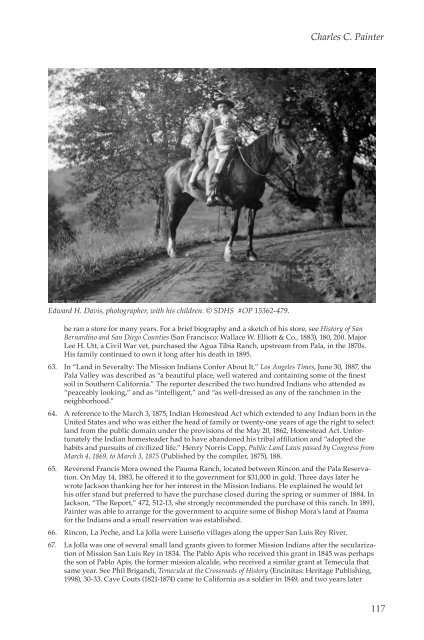The Journal of San Diego History - San Diego History Center
The Journal of San Diego History - San Diego History Center
The Journal of San Diego History - San Diego History Center
Create successful ePaper yourself
Turn your PDF publications into a flip-book with our unique Google optimized e-Paper software.
Charles C. Painter<br />
Edward H. Davis, photographer, with his children. © SDHS #OP 15362-479.<br />
he ran a store for many years. For a brief biography and a sketch <strong>of</strong> his store, see <strong>History</strong> <strong>of</strong> <strong>San</strong><br />
Bernardino and <strong>San</strong> <strong>Diego</strong> Counties (<strong>San</strong> Francisco: Wallace W. Elliott & Co., 1883), 180, 200. Major<br />
Lee H. Utt, a Civil War vet, purchased the Agua Tibia Ranch, upstream from Pala, in the 1870s.<br />
His family continued to own it long after his death in 1895.<br />
63. In “Land in Severalty: <strong>The</strong> Mission Indians Confer About It,” Los Angeles Times, June 30, 1887, the<br />
Pala Valley was described as “a beautiful place, well watered and containing some <strong>of</strong> the finest<br />
soil in Southern California.” <strong>The</strong> reporter described the two hundred Indians who attended as<br />
“peaceably looking,” and as “intelligent,” and “as well-dressed as any <strong>of</strong> the ranchmen in the<br />
neighborhood.”<br />
64. A reference to the March 3, 1875, Indian Homestead Act which extended to any Indian born in the<br />
United States and who was either the head <strong>of</strong> family or twenty-one years <strong>of</strong> age the right to select<br />
land from the public domain under the provisions <strong>of</strong> the May 20, 1862, Homestead Act. Unfortunately<br />
the Indian homesteader had to have abandoned his tribal affiliation and “adopted the<br />
habits and pursuits <strong>of</strong> civilized life.” Henry Norris Copp, Public Land Laws passed by Congress from<br />
March 4, 1869, to March 3, 1875 (Published by the compiler, 1875), 188.<br />
65. Reverend Francis Mora owned the Pauma Ranch, located between Rincon and the Pala Reservation.<br />
On May 14, 1883, he <strong>of</strong>fered it to the government for $31,000 in gold. Three days later he<br />
wrote Jackson thanking her for her interest in the Mission Indians. He explained he would let<br />
his <strong>of</strong>fer stand but preferred to have the purchase closed during the spring or summer <strong>of</strong> 1884. In<br />
Jackson, “<strong>The</strong> Report,” 472, 512-13, she strongly recommended the purchase <strong>of</strong> this ranch. In 1891,<br />
Painter was able to arrange for the government to acquire some <strong>of</strong> Bishop Mora’s land at Pauma<br />
for the Indians and a small reservation was established.<br />
66. Rincon, La Peche, and La Jolla were Luiseño villages along the upper <strong>San</strong> Luis Rey River.<br />
67. La Jolla was one <strong>of</strong> several small land grants given to former Mission Indians after the secularization<br />
<strong>of</strong> Mission <strong>San</strong> Luis Rey in 1834. <strong>The</strong> Pablo Apis who received this grant in 1845 was perhaps<br />
the son <strong>of</strong> Pablo Apis, the former mission alcalde, who received a similar grant at Temecula that<br />
same year. See Phil Brigandi, Temecula at the Crossroads <strong>of</strong> <strong>History</strong> (Encinitas: Heritage Publishing,<br />
1998), 30-33. Cave Couts (1821-1874) came to California as a soldier in 1849, and two years later<br />
117






![[PDF] The Journal of San Diego History Vol 52: Nos 1 & 2](https://img.yumpu.com/25984149/1/172x260/pdf-the-journal-of-san-diego-history-vol-52-nos-1-2.jpg?quality=85)

![[PDF] The Journal of San Diego History - San Diego History Center](https://img.yumpu.com/25984131/1/172x260/pdf-the-journal-of-san-diego-history-san-diego-history-center.jpg?quality=85)







